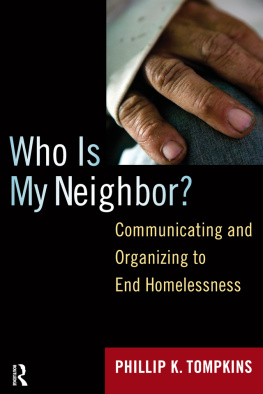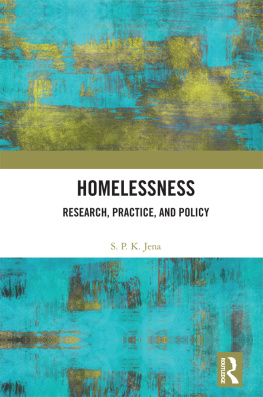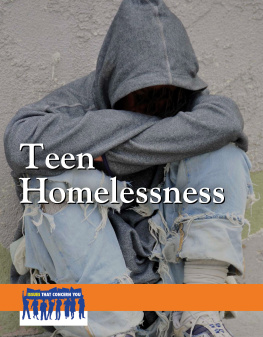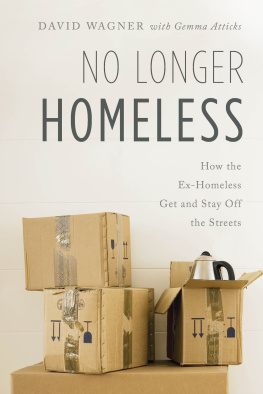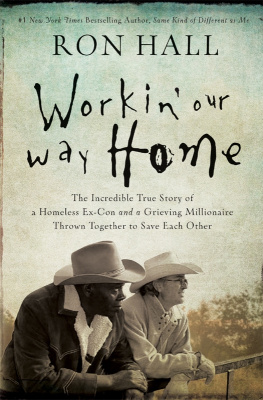First published 2009
by Paradigm Publishers
Published 2016
by Routledge
2 Park Square, Milton Park, Abingdon, Oxon OX14 4RN
711 Third Avenue, New York, NY 10017, USA
Routledge is an imprint of the Taylor & Francis Group, an informa business
Copyright 2009, Taylor & Francis.
All rights reserved. No part of this book may be reprinted or reproduced or utilised in any form or by any electronic, mechanical, or other means, now known or hereafter invented, including photocopying and recording, or in any information storage or retrieval system, without permission in writing from the publishers.
Notice:
Product or corporate names may be trademarks or registered trademarks, and are used only for identification and explanation without intent to infringe.
Library of Congress Cataloging-in-Publication Data
Tompkins, Phillip K.
Who is my neighbor?: communicating and organizing to end homelessness /
Phillip K. Tompkins.
p. cm.
Includes bibliographical references and index.
ISBN 978-1-59451-647-4 (hardcover: alk. paper)ISBN 978-1-59451-648-1
(pbk.: alk. paper)
1. HomelessnessColoradoDenver. 2. Homeless personsColoradoDenver.
3. Homeless personsServices forDenverColorado. 4. Shelters for the
homelessColoradoDenver. 5. Tompkins, Phillip K. I. Title.
HV4046.D45T65 2009
362.5'83dc22
2008042254
ISBN 13: 978-1-59451-647-4 (hbk)
ISBN 13: 978-1-59451-648-1 (pbk)
Designed and Typeset by Straight Creek Bookmakers.
This book is a metanarrative of short stories and numbers. Some critics dismiss stories as anecdotal evidence, while others refer to quantification as reductionism. But all we have are stories and numbers. My purpose is to introduce the stories of homeless people and numbers about them to allow the reader to learn as I did, listening to the guests at a homeless shelter speak for themselves. In addition, I provide insights I gained from other people who have studied homeless people and from the rich literature written by people who have experienced being down and out and on the road. This book is almost completely true. It does change names to protect the identity of homeless people.
This unfolding method is also the best way I know to grasp the complexity of the problem. It is tempting to oversimplify homelessness in either of two directions: One is to blame the victim, making homelessness a symptom of weak character; the other is to make it all a matter of economics. I was tempted at timesand it shows at places in the bookto use the second approach. I will show, however, the weakness of giving in to this temptation. Some say the answer is simply to ask the federal government to throw money at the problem. My purpose, again, is to show how coordinated action by a diverse set of interestsincluding each person reading this bookis required.
The book differs in another way from the social scientific literature on social problems. I spend some time evaluating policies of the past and those recently introduced. I want to help find a rational, pragmatic way to eliminate homelessness, not just to study it. During the decade I have worked with and studied homeless people, I became an advocate for them, a role I adopt readily in this book as well.
I also want to bring the reader close to the guests I met at a remarkable institution: the St. Francis Center, a homeless shelter in Denver, Colorado. I provide, again through short stories and numbers, the culture of the organization. For ten years I have worked there as a volunteer one day a week, learning about the people, the problem, the failed policies of the past, and the promising ones introduced and tested in the past few years. I am confident that we are making progress in eliminating the problem.
Some have asked about the meaning of the title. Some encouraged me to include an explication of it in the book: The Parable of the Good Samaritan appears in the New Testament (Luke 10:2537). In this powerful story a lawyer stood up to test Jesus by asking him how to live in such a way as to inherit eternal life. Jesus asks him in return what is written in the law. The lawyer answers, You should love the Lord your God with all your heart, and with all your soul, and with all your strength, and with all your mind; and your neighbor as yourself. Jesus compliments him, saying he has given the right answer.
Wanting to justify himself, the lawyer asks, And who is my neighbor?
Jesus answers with the story of the Jew who was beaten and robbed and left for dead on the road from Jerusalem to Jericho. Two separate Jews, one a priest, walk by him without offering any assistance. The Samaritan, a foreigner who is not expected to help Jews, stops, treats him with oil and wine, and then takes him to an inn. He gives the innkeeper money to pay for his food, care, and lodging. He promises to return to pay more if necessary.
The lawyer was really asking, Who is not my neighbor? The point of the story is that everyone is your neighbor, even foreigners who despise you. The Samaritan gave housing, gave shelter, to a complete stranger, a homeless man.
There are many people I want to thank: Let me begin with Tom Luehrs and Jean Garrison, the top two administrators at the St. Francis Center (SFC). They have been admirable bosses and mentors. They both read a longer version of this book in manuscript form, catching factual errors and making suggestions. To them I add the rest of the full-time and volunteer staff. And of course, the most important people at SFC: our guests.
I want to thank Matthew Nickaloff for reading the first draft of the first three or four chapters and making suggestions. Thanks also to Larry Browning for the same kind of help at an early stage. Not only is Gregory Desilet a good reader, but he also let me test the ideas included in this book against his sharp mind in conversations over the past ten years. Thanks also to Omar Swartz, who wisely edited my two published essays on homelessness. I am greatly indebted to Roxane White, who cheerfully answered my questions, including those about the processes used by a commission she chaired: The Commission to End Homelessness in Denver within the Decade. She also read those passages relevant to her work as the head of Denvers Department of Human Services. Thanks also go out to two perspicacious and helpful editors at Paradigm Publishers: Jessica Priest and Jennifer Knerr. They made the process of acquisition and editing as delightful as possible. Others of their colleagues at Paradigm served me well, including my production editor, Carol Smith, and superb copy editor, Kathy Delfosse.
Finally, I dedicate this book to my colleague, editor, and wife, Elaine:

